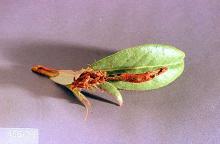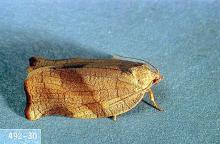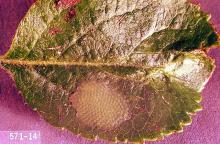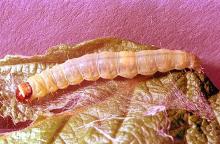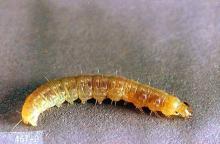Includes
Oblique-banded leafroller (Choristoneura rosaceana)
Orange tortrix (Argyrotaenia franciscana = A. citrana)
Pest description and crop damage Both species are found in blueberries. Depending on the region, one species may be more dominant than the other. Adults of these two species are buff-colored moths with a wingspan of 12 to 20 mm, and bell-shaped at rest. As the name indicates, the oblique-banded leafroller moth has a dark band across its wings. The larvae of the orange tortrix are light cream to green with light brown heads and are up to 12 mm long at maturity. Oblique-banded larvae can be 12 to 25 mm in length and have darker green bodies with dark brown to black heads. The larvae roll and tie leaves together with silk for shelter and feeding; they wriggle and thrash about violently when disturbed. Eggs are green and laid on leaves in clusters of up to 200 eggs. They hatch in about 10 to 14 days.
The larvae feed on leaves, which causes relatively minor damage. Feeding on growing points on young plants can promote undesirable branching. Loss of fruit quality can occur from the binding of leaves to developing fruit, and if the larvae contaminate the fruit in mechanically harvested fields. Larval feeding on blossoms is thought to spread Botrytis fruit disease.
Biology and life history Both species overwinter as larvae on a variety of host plants. Larvae may feed during warm periods in winter but become active in spring with onset of new growth. Pupation occurs within the larval leaf roll. Depending on the species, adult moths emerge from April to July. These adults lay eggs for the next generation. There are two to three generations per year.
Scouting Observe early spring growth for rolled leaves and feeding damage on new growth. Larvae move from plant to plant, and between fields, on silken threads; this silk can be easily seen upon close inspection or if viewed in the slanting sunlight. Pheromone traps are available for monitoring adult male flight. These can help to determine the timing of adult emergence and the timing of larvae presence. Pheromone traps should be placed in fields beginning in late April or May and checked weekly. Starting one week after peak flight, leaves can be examined for larval infestation.
Management-biological control
Very low temperatures in winter significantly reduce overwintering populations. Spiders and parasitic/predatory insects greatly reduce leafroller populations throughout the year.
Management-cultural control
Removal of overwintering sites, such as rolled leaves on the ground or plastered to canes, can reduce next year's population. Avoid the use of broad-spectrum insecticides which can disrupt natural enemies.
Management-chemical control: HOME USE
Dormant-season spray
- horticultural oil-Some formulations OMRI-listed for organic use.
Growing-season spray
Avoid making applications of insecticides to plants in bloom to avoid bee injury. Follow all label directions.
- azadirachtin/neem oil-Some formulations are OMRI-listed for organic use.
- Bacillus thuringiensis var. kurstaki-Some formulations are OMRI-listed for organic use.
- bifenthrin
- carbaryl-Do not apply carbaryl during blossoming-extremely toxic to bees.
- esfenvalerate
- insecticidal soap-May require several applications. Some formulations are OMRI-listed for organic use.
- permethrin
- plant essential oils (garlic, peppermint, rosemary)-Some formulations are OMRI-listed for organic use.
- pyrethrins-Some formulations are OMRI-listed for organic use.
- spinosad-Some formulations are OMRI-listed for organic use.
- zeta-cypermethrin-Toxic to bees; do not apply when bees are foraging.
Management-chemical control: COMMERCIAL USE
- azadirachtin (Ecozin Plus and other brands)-Consult label for rate. PHI 0 days. Some formulations are OMRI-listed for organic use.
- Bacillus thuringiensis (Bt) (several brands)-Consult label for rate. PHI 0 days. A spreader-sticker increases efficacy. OMRI-listed for organic use.
- bifenthrin (Brigade and other brands) at 0.033 to 0.1 lb ai/A. PHI 1 day. Highly toxic to bees; do not apply during bloom. (Group 3)
- Burkholderia spp. (Venerate)-Consult label for rate. PHI 0 days.
- carbaryl (Sevin and other brands) at 2 lb ai/A. PHI 7 days. Use postbloom only. Latex-based formulations such as Sevin XLR Plus are less hazardous to bees. (Group 1)
- chlorantraniliprole (Altacor) at 0.066 to 0.099 lb ai/A. PHI 1 day. (Group 28)
- Chromobacterium subtsugae (Grandevo)-Consult label for rate. PHI 0 days.
- cyclaniliprole (Verdepryn 100SL) at 0.054 to 0.072 lb ai/A. PHI 1 day. Highly toxic to bees. (Group 28)
- fenpropathrin (Danitol) at 0.2 to 0.3 lb ai/A. PHI 3 days. Highly toxic to bees; do not apply during bloom. Restricted use pesticide. (Group 3)
- malathion (several brands) at 1.25 lb ai/A. PHI 1 day. Do not apply when bees are actively visiting the treatment area. SWD SLNs - check to see how they're different from the label and make a note. See Matthew Bucy's spreadsheet. (Group 1)
- methomyl (Lannate and others) at 0.9 lb ai/A. PHI 3 days. Do not apply during bloom. Restricted use pesticide. (Group 1)
- methoxyfenozide (Intrepid 2F and others) at 0.16 to 0.25 lb ai/A. PHI 7 days. For overwintering populations, make one to two applications between budbreak and petal fall, when young larvae are active. For the summer generation, begin applications at peak moth flight. Additional applications at 10- to 14-day intervals may be required under high pest pressure. Do not exceed three applications per season. (Group 18)
- novaluron (Rimon 0.83EC) at 0.13 to 0.19 lb ai/A. PHI 8 days. Apply when larvae are young and small.
- phosmet (Imidan 70W) at 1.0 lb ai/A. PHI 3 days. Do not exceed five applications per season. Do not apply to bloom. (Group 1)
- pyrethrins (PyGanic and others)-Consult label for rate. PHI 0 days. (Group3)
- spinetoram (Delegate WG) at 0.05 to 0.09 lb ai/A. PHI 3 days. SLN 24c OR-170016 for Delegate allows a 1-day PHI in Oregon only; read label carefully for restrictions on number of applications allowed. (Group 5)
- spinosad (Entrust) at 0.062 to 0.1 lb ai/A. PHI 3 days. Target application to small larvae or eggs at hatch. Toxic to bees for three hr following treatment. Do not apply when bees are foraging. Entrust is OMRI-listed for organic use. (Group 5)
- tebufenozide (Confirm 2F) at 0.25 lb ai/A. PHI 14 days. For overwintering populations, make one to two applications between budbreak and petal fall, when young larvae are active. For the summer generation, begin applications at peak moth flight. Additional applications at 10- to 14-day intervals may be required under high pest pressure. Do not exceed 1 lb ai/A product per season. (Group 18)
- zeta-cypermethrin (Mustang) at 0.025 lb ai/A. PHI 1 day. Restricted use pesticide.



